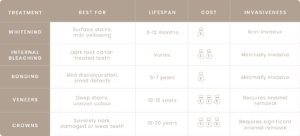How to Fix a Dark or Discoloured Tooth: Your Best Dental Options
11/04/2025
A dark or discoloured tooth can affect your confidence and make you self-conscious about your smile. Whether caused by trauma, decay, staining, or ageing, several dental treatments are available to restore a brighter, more natural appearance.
Here’s a breakdown of the most effective options, including their advantages and disadvantages.
Professional Teeth Whitening
If the discolouration is caused by external staining (coffee, tea, smoking, or ageing), professional whitening may be the most straightforward and least invasive solution.
How It Works:
- A dentist applies a potent bleaching gel to the tooth, sometimes activated by light or laser.
- Whitening can be done in the clinic for fast results or with a custom take-home kit.
Advantages:
- Quick & non-invasive – No drilling or tooth alteration required.
- Effective for external stains – Brightens yellow, brown, or surface-stained teeth.
- Immediate results with in-office whitening.
Disadvantages:
- Doesn’t work well on deep internal stains or dead teeth.
- Temporary results – May need repeat treatments every 6-12 months.
- It can cause temporary tooth sensitivity.
Internal Bleaching (For Root Canal-Treated Teeth)
If a tooth has darkened due to trauma or a root canal, traditional whitening won’t work. Internal bleaching is an option to lighten the tooth from the inside.
How It Works:
- A dentist places a whitening agent inside the tooth.
- The tooth is sealed, and the bleach works over a few days.
- The process may need to be repeated until the desired shade is achieved.
Advantages:
- Effective for dark, root canal-treated teeth.
- Less invasive than veneers or crowns.
- Preserves the natural tooth structure.
Disadvantages:
- Only works on non-vital (dead) teeth.
- It is not a permanent fix – It may need retreatment over time.
- If the tooth is very weak, other restorations (like a crown) may be a better option.
Dental Bonding (Composite Veneer for One Tooth)
A quick and affordable way to improve the appearance of a discoloured tooth is composite bonding, where tooth-coloured resin is applied to the tooth’s surface.
How It Works:
- A dentist applies a tooth-coloured composite material to cover the discolouration.
- The material is shaped, polished, and hardened to blend with surrounding teeth.
Advantages:
- Minimally invasive – No significant enamel removal is required.
- Quick & affordable – Often completed in one visit.
- Good for mild to moderate discolouration.
Disadvantages:
- Not as durable as crowns or veneers – May chip or stain over time.
- Shorter lifespan (5-7 years) compared to other treatments.
- Not suitable for very dark teeth – May not fully mask severe discolouration.
Porcelain Veneers
A porcelain veneer is a long-lasting and aesthetic solution for severely discoloured teeth.
How It Works:
- A thin custom-made porcelain shell is bonded to the front of the tooth.
- The dentist may remove a small amount of enamel to ensure a natural fit.
Advantages:
- Completely covers deep discolouration.
- Looks natural & stain-resistant.
- Long-lasting solution (10-15 years with proper care).
Disadvantages:
- Irreversible – Requires some enamel removal.
- More expensive than bonding or whitening.
- If a single veneer is done, matching it to other teeth can be tricky.
Dental Crowns (For Severely Dark or Damaged Teeth)
A dental crown is the best option if a tooth is both discoloured and structurally weak (e.g., from trauma or a large filling).
How It Works:
- The dentist prepares the tooth and takes an impression.
- A custom-made porcelain, ceramic, or zirconia crown is placed over the entire tooth.
Advantages:
- Completely restores a severely discoloured or weak tooth.
- Long-lasting solution (10-20 years).
- Protects the tooth from further damage.
Disadvantages:
- Requires more enamel removal than veneers.
- More expensive than bonding or whitening.
- If done on a single front tooth, matching the exact shade to surrounding teeth can be challenging.
Which Option is Best for You?

Final Thoughts
The right treatment for a dark or discoloured tooth depends on the cause of the discolouration, the severity, and your long-term goals. If the issue is surface staining, whitening may be enough. However, for deep stains, trauma, or structural damage, options like bonding, veneers, or crowns may be the best choice.
If you’re unsure which solution is right for you, book a consultation with your dentist to discuss the best way to restore your smile and confidence!
Would you like advice on maintaining a whiter smile after treatment?
Back to blog